I don’t usually pay much attention to suggestionbots. You know, those things on websites that say: “Based upon your interest in X may we suggest Y?” They tend to be either keyword-simplistic — “Since you searched the term Star Trek you will also be interested in Dancing with the Stars !” — or blatantly commmercial: “Surely anyone interested in Blade Runner would also be interested in a coupon for Starbucks.”
Every now and then though a ‘bot offers up something worthwhile. NetFlix tends to be better in this respect since their suggestions are category-based, and things brought to light from the corners of a category can be interesting.
And NetFlix really came through last night. I had been looking up movies with tanks — not water storage, armored combat vehicles, Mr. ‘Bot — and the system noted the preponderance of clicks on movies about WWII and offered up some suggestions. First on the list: The Rat Patrol.
Rat Patrol ! I didn’t even know it was available, let alone on streaming. I called it up and watched an episode, right that moment. Then watched three more this morning.
My wife happened by and asked what I was watching. It turned out she had never heard of it. But I will wager that mentioning the series to any American male born between 1950 and 1970 will get you a fond smile and a “Oh, yeah!”
Rat Patrol ran 58 episodes, 1965-68 on ABC, then saw syndication in the 70s and 80s. The show was 1/2 hour and had the distinction of being the first TV series about WWII to be televised in color. (A big selling point then — commercials and credits for the show prominently featured the phrase: “In Color”.)
The setting of the show is the deserts of North Africa. The premise is simple: four Allied soldiers tear-ass around the desert in machine-gun-mounted jeeps, harassing the Germans of Rommel’s Afrika Korps.
But that description is too dry, too bald, too straightforward to explain the thrill I felt when I saw the title, and does not begin to justify the boy-adrenalin that kicked in when I again saw the opening credits: the jeeps clearing the crest of a sand dune, to land with a spine-jarring crunch that must make every chiropractor in the world wince at once.
The video clip could really be from any episode, as frankly they were all almost exactly the same. Each episode title includes the word “Raid” — “The Kill or Be Killed Raid”, “The Do or Die Raid” — which gives a strong clue as to the nature of each story: a quick bold mission to blow up a fuel dump or waste an ammo dump or otherwise impede the Axis forces. The 30-minutes-less-commercials format did not allow much time for drama or complex military tactics (though our guys do spend quite a bit of time in enemy uniform to get into German camps), just a pedal-to-the-floorboard helpin’ of action.
The straightforward stories with their ritualized setups — the surveillance through binoculars, the donning of the goggles, the removal of the dust-sock from the machine gun barrel, even the blowing of the gum bubble — quickly became part of yard play for myself and my friends. We would enact what we could recall from the previous night’s episode, then move on to scenarios of our own. (The father of my friend across the street was a plumber; his work truck, a pickup with a pipe rack atop, was in our imagination our desert-camouflaged jeep and many a German ate dust from the back of it.)
Rat Patrol is remarkable for the unabashed nature of its violence. Unlike the goofy approaches to warfare of McHale’s Navy (1962-66) and Hogan’s Heroes (1965-71), Rat Patrol was a two-fisted exercise in kickin’ ass without bothering to take names. In one of the early episodes a Patroler infiltrates a German encampment and takes out several officers. He swipes a punch at one German and we see the German clutch his throat and go down; we realize the American had a straight razor in his hand and, while there is no “red red vino” as Little Alex would say, it is still clear that our boy has just slit an enemy’s throat. This is hardcore military action in strong contrast to the “plastic violence” that filled TV in the 80s. Bullets fly and people die.
In researching this show I learned some things I had forgotten or more likely never knew. If I had thought about it at all, I suppose I would have assumed that the show was filmed in the deserts of California. (Appropriate, since those deserts had previously been used for training Patton’s forces.) But the show’s first season was actually filmed in Spain, where lots of WWII materiel was still available: tanks, half-tracks, trucks, and artillery pieces. This equipment, plus war-leftover tents and uniforms, gives the series a realism far beyond its meager budget.
I was surprised to see actor Eric Braeden, portraying series nemesis Hauptmann (Captain) Dietrich, credited as Hans Gudegast. It turns out that Gudegast was his birth name. (Braeden may best be remembered as the lead in one of the best of the 70s SF movies, Colossus: The Forbin Project. He has also for years had steady work in soap operas.) The German-born actor brought realism to the role (early on his dialogue is in German; later episodes switch to English to keep things rolling) and made an excellent if low-key villain. Several of the episodes manage to involve personal interaction between the leaders of the opposing forces — there are even several instances where they have to work together against a common foe — and these episodes point up how much Braeden adds to the show as a “good bad guy.”
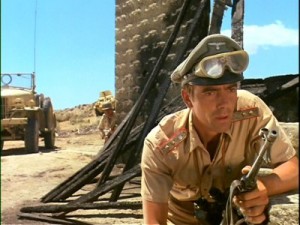
It is interesting to note that the leader of the Patrol is only a sergeant, an indication of American egalitarianism. German officers are generally portrayed as cultured, educated, clever, and intelligent — honorable foes, if not always likable. But the average German soldier is shown as a half-brained thug who lives in terror of the officer class. Bullet-catchers, whom we do not mind seeing blown away.
And the bullets do fly! Each episode features at least one scene where multiple machine guns are spitting comments at each other. Somehow our heroes are immune to this hail — we are left with the conviction that they are not bulletproof but will always prevail due to being quicker, bolder, more daring and, well, just more American than the enemy.
One element I wouldn’t have noticed as much when watching the series as a boy: the lovely women. Our men’s-men manage to find time between raids to dally with a variety of women: American, British, German, Arab, beauties all. (One striking femme was Miss Austria 1962.) In one memorable scene, after completing a daring raid our boys stop to acquire water from a comely Arab lass. They offer her money, and then a hat, in exchange. But she shakes her head at these items, pointing instead at Private Hitchcock (Lawrence Casey.) With a grin he says, “Well, fellas, this is what you call the supreme sacrifice! See you back at the ranch.” And off he goes with the dusky beauty.
There are indications that the Rat Patrol was originally envisioned as a multi-national force, with each man representing an Allied power and wearing an appropriate hat. Private Hitchcock wears a red French Foreign Legion cap (which we all thought was a Rebel cap, in the old days) that really stood out on color TVs. Sergeant Troy wears an Australian bush hat, which looks a bit affected but which Christopher George (now the subject of his own Cool Actor of the Week post) insisted was to honor the Aussie forces that fought in Greece. (Affectation or not, we all wanted one and I haunted the army surplus places until I found mine.) British Sgt. Jack Moffit (Gary Raymond) wears a beret, and all-American Pvt. Tully Pettigrew (Justin Tarr), “the best moonshine runner in Kentucky,” gets a GI brain-bucket.
The thin budget sometimes shows. Equipment varies between episodes, sometimes between scenes, and military purists could become dizzy trying to keep up with the inaccuracies of some of the gear. Action footage is often reused, a failing certainly not unique to this show but distracting even when I was a boy. The show’s quick episodes encourage conveniences best not looked at too closely — while we see that the jeeps travel with basic supplies, ammunition is magically inexhaustible and needed equipment suddenly shows up as though there is a whole supply column just over the hill. While some of the episodes involve what would be huge centralized explosions, the screen reality is a number of small explosions in unlikely places.
But all that is just quibbling. Rat Patrol delivers just what it promises: hard-hitting action stories with no distracting discussions as to the righteousness of the cause. In that, the series is really more like an old Western serial: quick satisfying stories of the White Hats triumphing over the Black Hats. The exciting balls-out action (Christopher George, “Sgt. Troy,” was injured when a jeep overturned during filming, the injury later contributing to his death) and simple storylines stirred the blood of every boy who ever saw an episode. In fact the simplicity of the storylines, sometimes criticized, is one of the show’s greatest strengths — not only was the series immediately graspable, each story might actually have been written by any of the boys watching it.
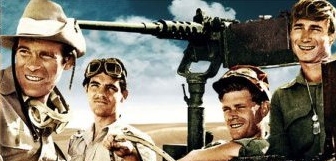
And that’s why seeing the name of the series, then watching the opening credits, then hearing the stirring Dominic Frontiere theme music, each added to my excitement to the point where I had to write this review. Watching The Rat Patrol, I was instantly transported to occupy my younger self, a self who wanted and appreciated rowsing clear-cut stories of two-fisted action, a younger self who became this older self who really still just wants to suspend his disbelief and tear-ass around the desert firing machine guns and Blowing Shit Up in a good cause.
Cheese Bits:
Dominic Frontiere, who did the theme music, also did music for The Invaders, The Outer Limits, and The F.B.I; and the movies Hang ’em High, Chisum, and The Stunt Man (for which he won a Golden Globe award).
Christopher George married Lynda Day in 1970. The couple co-starred in many films until his death in 1983. He was also the uncle of “Wheel of Fortune” hostess Vanna White.
Guest stars to watch for on The Rat Patrol:
- Ed Asner (as a German doctor)
- Warren Stevens (Doc Ostro from Forbidden Planet)
- Gavin McLeod (Moriarty from Kelly’s Heroes)
- Stanley Adams (Harry Mudd from Star Trek)
- Claudine Longet
- John Anderson (from several Twilight Zone episodes)
- Fabian
- Martin Milner
- William Schallert
- Richard Mulligan (Soap!, Empty Nest)
- Vincent Gardenia
- Joe Turkel (Dr. Eldon Tyrell from Blade Runner, Lloyd the Bartender from The Shining)
- Jack Jones (singer)
- Dick Sargent
Followup:
It warms my heart to report that the term “Rat Patrol” is used in today’s U.S. Army for convoy escorts and fast scout patrols. Most of the young fellows tooling around in Desert Patrol Vehicles probably have no idea as to the heritage of the term, but it is in daily usage!
Here are some images of the modern version of the jeeps the Rat Patrol used. Desert Patrol Vehicles (a type of “Light Strike Vehicle”) are more dune buggy than jeep — something you’d want under you during a really serious Baja Enduro, something akin to Death Race — but you can see the same general design: a fast, light vehicle packing a .50-cal.
Dune buggies you could ride into the dustier parts of Hell.


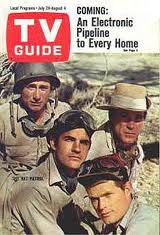
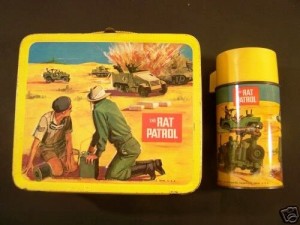
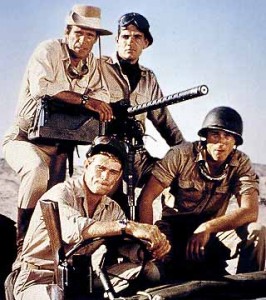
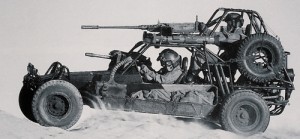
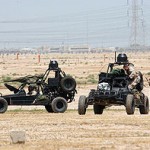
There is one comment